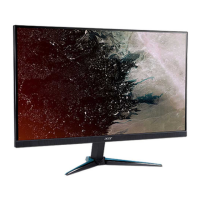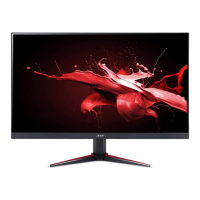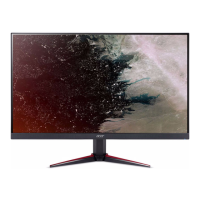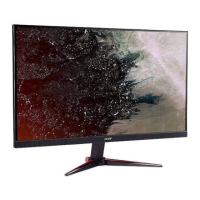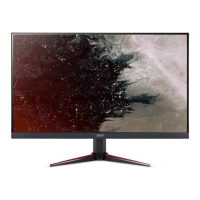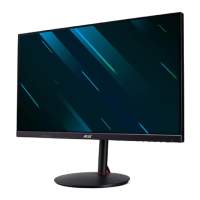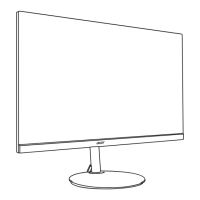Do you have a question about the Acer NITRO VG0 VG240YS and is the answer not in the manual?
General safety guidelines for product use and handling.
Information on normal LCD behavior and potential pixel variations.
Instructions on how to clean the monitor safely and effectively.
Guidance on ensuring the power outlet is accessible.
Instructions to protect hearing while using the monitor.
Warnings regarding product placement, ventilation, and overheating.
Key warnings related to using electrical power safely.
Safety tips for using extension cords and grounding.
Conditions requiring qualified service personnel.
Precautions for hazardous environments and small parts.
Information on IT equipment recycling and proper disposal.
Explanation of acceptable pixel variations on LCD screens.
Preventing eyestrain, physical injury, and optimizing posture.
Tips to reduce eyestrain and care for your eyes.
Advice for productive and relaxing computer use.
Declares compliance with EU directives and standards.
States FCC compliance and identifies the responsible party.
List of items to verify upon unpacking.
Guide to assembling the base and adjusting tilt.
Instructions for power connection and power saving states.
DDC overview and 19-pin cable pinout.
Detailed pin description for the 20-pin signal cable.
Table of standard display modes, resolutions, and refresh rates.
Connecting the monitor and explanation of FreeSync.
Identification and function of physical monitor controls.
Navigating the OSD and using hot keys for settings.
Choosing inputs and fine-tuning picture parameters.
How to enable and configure HDR for enhanced visuals.
Displaying HDR status and how HDR affects settings.
Adjusting color balance, luminance, and selecting color modes.
Controls for audio and gaming-specific features like FreeSync.
Customizing OSD behavior and security features.
Configuring input sources, DP format, and aspect ratio.
PC control, HDMI levels, and saving custom profiles.
Common display problems and their solutions.
General safety guidelines for product use and handling.
Information on normal LCD behavior and potential pixel variations.
Instructions on how to clean the monitor safely and effectively.
Guidance on ensuring the power outlet is accessible.
Instructions to protect hearing while using the monitor.
Warnings regarding product placement, ventilation, and overheating.
Key warnings related to using electrical power safely.
Safety tips for using extension cords and grounding.
Conditions requiring qualified service personnel.
Precautions for hazardous environments and small parts.
Information on IT equipment recycling and proper disposal.
Explanation of acceptable pixel variations on LCD screens.
Preventing eyestrain, physical injury, and optimizing posture.
Tips to reduce eyestrain and care for your eyes.
Advice for productive and relaxing computer use.
Declares compliance with EU directives and standards.
States FCC compliance and identifies the responsible party.
List of items to verify upon unpacking.
Guide to assembling the base and adjusting tilt.
Instructions for power connection and power saving states.
DDC overview and 19-pin cable pinout.
Detailed pin description for the 20-pin signal cable.
Table of standard display modes, resolutions, and refresh rates.
Connecting the monitor and explanation of FreeSync.
Identification and function of physical monitor controls.
Navigating the OSD and using hot keys for settings.
Choosing inputs and fine-tuning picture parameters.
How to enable and configure HDR for enhanced visuals.
Displaying HDR status and how HDR affects settings.
Adjusting color balance, luminance, and selecting color modes.
Controls for audio and gaming-specific features like FreeSync.
Customizing OSD behavior and security features.
Configuring input sources, DP format, and aspect ratio.
PC control, HDMI levels, and saving custom profiles.
Common display problems and their solutions.
| Screen Size | 23.8 inches |
|---|---|
| Resolution | 1920 x 1080 (Full HD) |
| Panel Type | IPS |
| Refresh Rate | 165Hz |
| Brightness | 250 nits |
| Contrast Ratio | 1000:1 |
| Adaptive Sync | AMD FreeSync Premium |
| Aspect Ratio | 16:9 |
| Viewing Angle | 178° (H) / 178° (V) |
| Color Gamut | 72% NTSC |
| Color Depth | 8-bit |
| VESA Mount | 100 x 100 mm |
| Tilt | -5° to 20° |
| Ports | 1 x DisplayPort |
